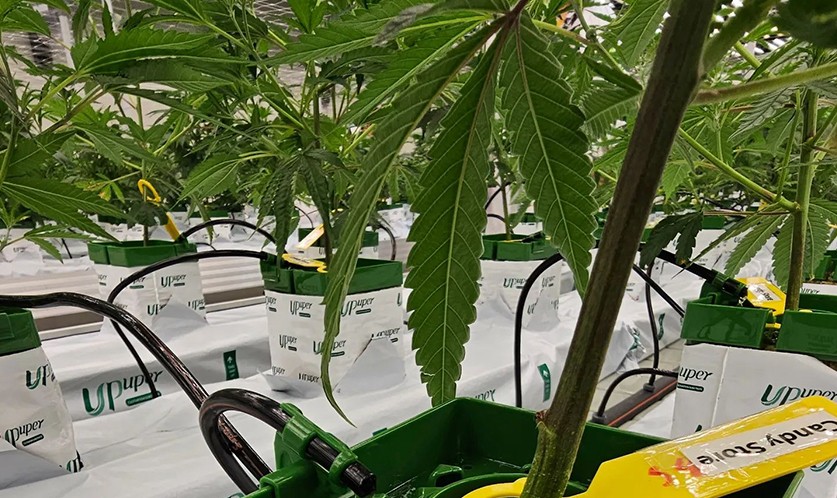In the world of cannabis cultivation, hydroponics dominates the scene. This technique allows cannabis to thrive in a controlled environment, safeguarding it from potential threats like pests and diseases. Yet, within hydroponics, growers have a myriad of substrate options to choose from, such as rock wool and coco coir. This article will delve into the advantages of these hydroponic substrates and soil when it comes to cannabis cultivation.
Rockwool Substrate
Rockwool is an inorganic, fibrous growing medium made from melting natural rocks. It boasts exceptional air and water retention capabilities. With a porosity rate of about 95%, rock wool surpasses the majority of hydroponic substrates. In cannabis cultivation, the cavities within the rock wool cater perfectly to the respiration level required by the cannabis root system, ensuring the roots always remain in an optimal growth environment.
Its inorganic nature means that the nutrient solutions used by growers can be delivered to the cannabis root system virtually unaffected, allowing the plant to consistently receive the nutrients it needs for development and flowering during its vegetative and reproductive growth stages.
In the hydroponics industry, where environmental control is emphasised, rock wool can mitigate the risks of soil-borne diseases like the Fusarium fungus or Bacterial wilt. UPuper rock wool substrate boasts an inherent sterilization advantage in its production process. All UPuper rock wool substrate products are produced at temperatures exceeding 1400°C. This ensures no bacteria can infiltrate the UPuper rock wool substrate to harm the plants.
As previously highlighted, UPuper rock wool substrate possesses an ultra-high porosity. Depending on the irrigation system set up by the grower, managing water, air, and nutrients within the UPuper rock wool substrate becomes rather convenient.
The UPuper rock wool substrate is notably durable. Growers can reuse the UPuper rock wool substrate for consecutive cannabis cultivation. However, it's imperative to thoroughly sterilize all products before reusing them.
Coco Coir
Coco coir is derived from the husk of Cocos and stands as an organic medium. It boasts a slightly elevated porosity, providing plant roots with a decent level of oxygen for respiration.
The fibers of Coco coir are capable of absorbing some nutrient solutions to feed the plant's root system. However, due to its natural composition, there's uneven stacking density of fibers inside the coir, leading to discrepancies in nutrient solution retention. This implies that plant roots might not stretch out to every nook and cranny during usage like they could in a rock wool substrate.
Compared to traditional soil, harmful microbes in Coco coir are somewhat controlled. But its organic nature means there's still a possibility of pathogens inhabiting the coir substrate. Still, with consistent monitoring and necessary management by growers, these harmful microbes can be controlled.
Coco coir is biodegradable, making it an eco-friendly substrate. However, this also introduces another challenge. Over time, as coir degrades, it might release substances that can alter the element content of nutrient solutions. This makes it challenging for growers to precisely control parameters like specific element content, pH, etc., in the nutrient solution. Moreover, reusing nutrient solutions becomes quite an ordeal for growers when using Coco coir as a substrate. The reason is, the liquid filtered from the coir turns a deep brown, making it difficult for typical ultraviolet disinfection systems to effectively sanitise and recycle the nutrient solution.
Soil
Soil has traditionally been the go-to medium for cannabis cultivation, packed with organics, minerals, and microbes. The porosity within the soil can vary significantly, depending on the type of soil in question (sandy, loamy). When cultivating cannabis outdoors in soil, the uncontrollable environment might expose the plants to a higher risk of pests and diseases.
One of the principal advantages of soil is its rich content of organic matter and microbes, ensuring a sustained nutrient supply for plants. While this natural medium can foster the growth of cannabis, the absence of a strict nutrient regimen can lead to inconsistencies in the final harvest quality. However, this also means that there's less need for frequent fertilization. For growers cultivating cannabis on a large scale in an environment conducive to its growth, using soil can significantly cut down on labor and resources related to fertilization.
For beginners venturing into cannabis cultivation, soil serves as a forgiving medium. Its buffering capacity offers a safety net for novice mistakes. Newbies can first familiarize
themselves with the growth habits of cannabis through soil cultivation and gradually transition to soilless cultivation techniques.
Summary
Rock wool substrate offers growers an entirely controllable root zone environment. Coco coir is a fantastic choice for those leaning towards organic substrates. Meanwhile, soil provides an amiable starting point for beginners dipping their toes into cannabis cultivation. When deciding on the medium for growing cannabis, factors like the cultivation environment, management skills, and expected yields should be considered. Every medium has its ideal application, and choosing the one that best suits your needs can ensure healthy growth and high yields for your cannabis plants.







